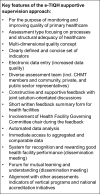Towards improved health service quality in Tanzania: An approach to increase efficiency and effectiveness of routine supportive supervision
- PMID: 30192783
- PMCID: PMC6128487
- DOI: 10.1371/journal.pone.0202735
Towards improved health service quality in Tanzania: An approach to increase efficiency and effectiveness of routine supportive supervision
Abstract
Effective supportive supervision of healthcare services is crucial for improving and maintaining quality of care. However, this process can be challenging in an environment with chronic shortage of qualified human resources, overburdened healthcare providers, multiple roles of district managers, weak supply chains, high donor fragmentation and inefficient allocation of limited financial resources. Operating in this environment, we systematically evaluated an approach developed in Tanzania to strengthen the implementation of routine supportive supervision of primary healthcare providers. The approach included a systematic quality assessment at health facilities using an electronic tool and subsequent result dissemination at council level. Mixed methods were used to compare the new supportive supervision approach with routine supportive supervision. Qualitative data was collected through in-depth interviews in three councils. Observational data and informal communication as well as secondary data complemented the data set. Additionally, an economic costing analysis was carried out in the same councils. Compared to routine supportive supervision, the new approach increased healthcare providers' knowledge and skills, as well as quality of data collected and acceptance of supportive supervision amongst stakeholders involved. It also ensured better availability of evidence for follow-up actions, including budgeting and planning, and higher stakeholder motivation and ownership of subsequent quality improvement measures. The new approach reduced time and cost spent during supportive supervision. This increased feasibility of supportive supervision and hence the likelihood of its implementation. Thus, the results presented together with previous findings suggested that if used as the standard approach for routine supportive supervision the new approach offers a suitable option to make supportive supervision more efficient and effective and therewith more sustainable. Moreover, the new approach also provides informed guidance to overcome several problems of supportive supervision and healthcare quality assessments in low- and middle income countries.
Conflict of interest statement
The authors have declared that no competing interests exist.
Figures






Similar articles
-
Towards improved health service quality in Tanzania: contribution of a supportive supervision approach to increased quality of primary healthcare.BMC Health Serv Res. 2019 Nov 20;19(1):848. doi: 10.1186/s12913-019-4648-2. BMC Health Serv Res. 2019. PMID: 31747932 Free PMC article.
-
Embedding systematic quality assessments in supportive supervision at primary healthcare level: application of an electronic Tool to Improve Quality of Healthcare in Tanzania.BMC Health Serv Res. 2016 Oct 13;16(1):578. doi: 10.1186/s12913-016-1809-4. BMC Health Serv Res. 2016. PMID: 27737679 Free PMC article.
-
Facilitators and barriers to effective supervision of maternal and newborn care: a qualitative study from Shinyanga region, Tanzania.Glob Health Action. 2021 Jan 1;14(1):1927330. doi: 10.1080/16549716.2021.1927330. Glob Health Action. 2021. PMID: 34148525 Free PMC article.
-
Re-aligning Incentives to Address Informal Payments in Tanzania Public Health Facilities: A Discrete Choice Experiment.Int J Health Policy Manag. 2023;12:6877. doi: 10.34172/ijhpm.2022.6877. Epub 2022 Dec 3. Int J Health Policy Manag. 2023. PMID: 37579473 Free PMC article. Review.
-
Examining the evidence for best practice guidelines in supportive supervision of lay health care providers in humanitarian emergencies: A systematic scoping review.J Glob Health. 2022 Feb 27;12:04017. doi: 10.7189/jogh.12.04017. eCollection 2022. J Glob Health. 2022. PMID: 35265328 Free PMC article.
Cited by
-
Availability and functionality of neonatal care units in healthcare facilities in Mtwara region, Tanzania: The quest for quality of in-patient care for small and sick newborns.PLoS One. 2022 Nov 21;17(11):e0269151. doi: 10.1371/journal.pone.0269151. eCollection 2022. PLoS One. 2022. PMID: 36409741 Free PMC article.
-
Quality of health service in the local government authorities in Tanzania: a perspective of the healthcare seekers from Dodoma City and Bahi District councils.BMC Health Serv Res. 2024 Jan 16;24(1):81. doi: 10.1186/s12913-023-10381-2. BMC Health Serv Res. 2024. PMID: 38229095 Free PMC article.
-
Towards improved health service quality in Tanzania: contribution of a supportive supervision approach to increased quality of primary healthcare.BMC Health Serv Res. 2019 Nov 20;19(1):848. doi: 10.1186/s12913-019-4648-2. BMC Health Serv Res. 2019. PMID: 31747932 Free PMC article.
-
Towards improved health service quality in Tanzania: appropriateness of an electronic tool to assess quality of primary healthcare.BMC Health Serv Res. 2019 Jan 22;19(1):55. doi: 10.1186/s12913-019-3908-5. BMC Health Serv Res. 2019. PMID: 30670011 Free PMC article.
-
"We do what we can do to save a woman" health workers' perceptions of health facility readiness for management of postpartum haemorrhage.Glob Health Action. 2020;13(1):1707403. doi: 10.1080/16549716.2019.1707403. Glob Health Action. 2020. PMID: 31928163 Free PMC article.
References
-
- World Health Organization. The World Health Report: Health System Financing. Geneva: World Health Organisation, 2010.
-
- Sustainable Development Solution Network. Indicators and a Monitoring Framework for the Sustainable Development Goals. Sustainable Development Solution Network, United Nations, 2015.
-
- Peabody JW, Taguiwalo MM, Robalino DA, Frenk J. Improving the Quality of Care in Developing Countries In: Jamison DT, Breman JG, Measham AR, Alleyne G, Claeson M, Evans DB, et al., editors. Disease Control Priorities in Developing Countries. 2nd ed Washington (DC)2006.
Publication types
MeSH terms
LinkOut - more resources
Full Text Sources
Other Literature Sources

